


Digest 2013-14 Winter/Spring Artistic Line
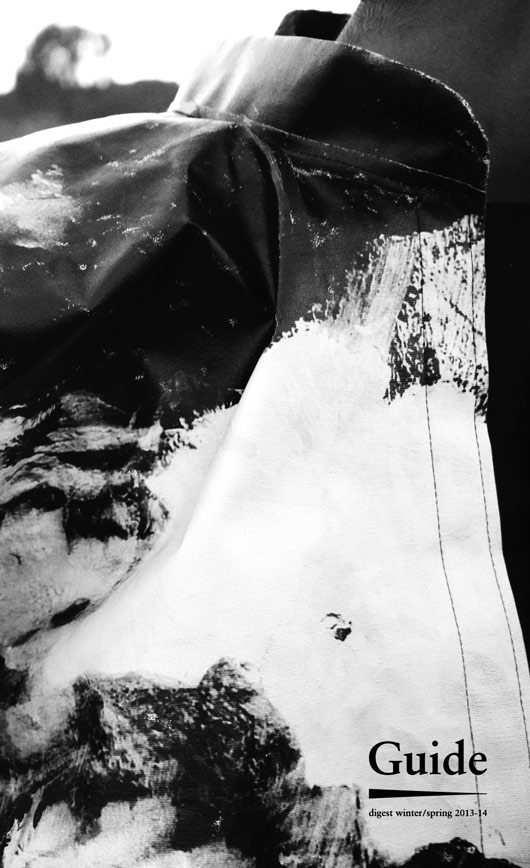
概念系列“化” [ 向导 Guide ]
这季成衣系列快要完成的时候,朋友给我带来了一件仅在斗牛节时穿着的贵州黑苗亮布男服。衣服的面料非常特别,朋友告诉我,苗族人用牛血混合蛋清,再以手工砸染入棉布。整件衣服的质地像韧度很高的牛皮纸,充满了不可思议的光泽,如果不知道其由来,会以为是现代高科技产物,一个略懂材料的朋友说看起来像杜邦纸。
原本,我已经放弃做这次的概念系列,因为突然找不到要做的理由了。在做前五季概念系列时,我也已经不止一次的问自己,到底概念系列要做的是什么“概念”?曾经读到一篇文章说,在古希腊,人们认为衣服是生活的向导,同时,只有真正的智者 philosopher 可以不着底衣,直接将衣料披挂在身上。我总是诗意地想,古希腊人民热爱和谐与自然,所以将衣物称呼为“向导”。当时,我并不知道,在保留了原始生活习俗的少数民族,是这样去制作祭祀服。而这些在祭典上穿的衣物,并不会在日常被穿着。在祭祀时,衣服承担了一个“通灵”的媒介,连通了先祖与当下。穿衣者的精神被引领到了一个在常态生活中不会去到的地方。古希腊人有着极为理性的思维,也许,被他们称作“向导”的衣物,正如同苗族这件斗牛节祭祀服,满载了人们渴望与先人沟通的意念。
想通了这些问题,衣服的样子已然浮现。想起潜浅说,拍到喜马拉雅山脉那天的景象让她永生难忘,能透过飞机窗户捕捉到这样的照片,也仿若神迹降临,但现在能清晰记得的也只有当时的颤栗,在观看照片时才能回忆起那天的景象。我们便将照片在三件衣服上做了不同程度的叠加,试图传递这种“自我营造的记忆场域”。在最后一件衣服上,山峰变成了纯白色,所有肌理和周围的云朵全部消失,隐入阴影中。
古人说,先人是山,也许,固执地要去做出这些不可穿的衣服,在心底,我希望能看见那座山。
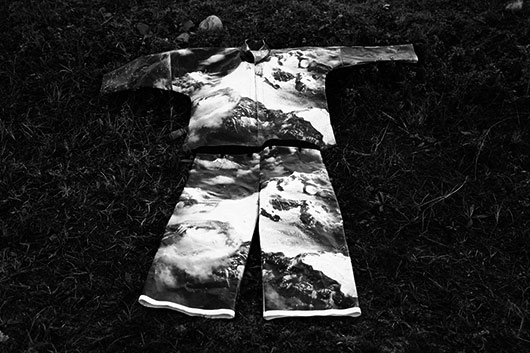
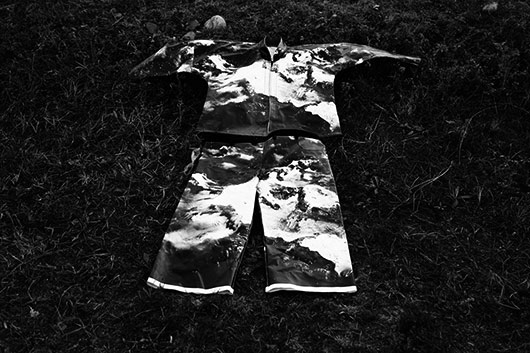
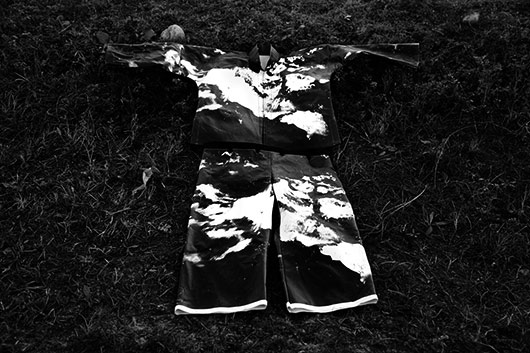
Artistic Line Hua [ Guide ]
Prior to the completion of the RTW line of this season, a friend brought me a male costume of the Hei Miao minority from Guizhou province, only worn on their Bull-fighting Festival. The material of the clothes is quite unique. According to this friend, the Miao mixes bull blood with egg white, and dyes the cotton clothes with the mixture by hand. The texture of the clothes is like a sheet of high-density packing paper with an unimaginable sheen. If you were not told about its origin, you would think it is a high-tech product, another friend who is an expert on materials suggested that it looked like Tyvek paper.
Initially, I had already given up on this season's conceptual line, because I couldn't find any reason for producing a line. And in the making of the previous five seasons, I have asked myself multiple times, what type of "concepts" should I produce in the conceptual line. I have once read an essay that expounds on clothes as a guide to life in the ancient Greek period, at the same time, the true philosophers would hang fabrics on their bodies without wearing any underwear. I always had the idyllic thoughts that the ancient Greeks loved harmony and nature, for which they have called clothes as their "guide". At the time, I was not aware that certain minority groups who passed on their original life customs still make clothes of worship in such methods. And the clothes worn on worship rituals were not worn on an everyday basis. In the time of worship, the clothes acted as a medium of "reaching the spirits", that connects the ancestors from the present. The soul of those wearing the clothes is guided to a place where they would not usually frequent. The ancient Greeks were known for their rational thinking, perhaps, the clothes they referred to as "guide" are like the costume of worship worn on the Bull-fighting Festival by the Miao minority, are vehicles of beliefs in communicating with the forefathers.
Once these issues are thought through, the forms of the clothes began to surface. I recall Qiananrchy has said, that the scenery of the Himalaya Mountain will be eternally memorable to her. The images she captured through the window of the airplane reached her spirits, but what she remembers the most today was the shivers, and it is only when she looks at the photographs would she recall the images seen on that day. We then overlapped the images on the three pieces of clothing to varying degrees, in attempt to create a "self-generated memory field". On the last piece, and mountain peaks became pure white, all textures and surrounding clouds have disappeared, fading into its surrounding shadows.
The ancients have said, first there was the mountain. Perhaps, I was quite persistent in making these non-wearable clothes, but subconsciously, it was my wish to see the mountain.
Text: Dooling Jiang
English Translation: Fiona He

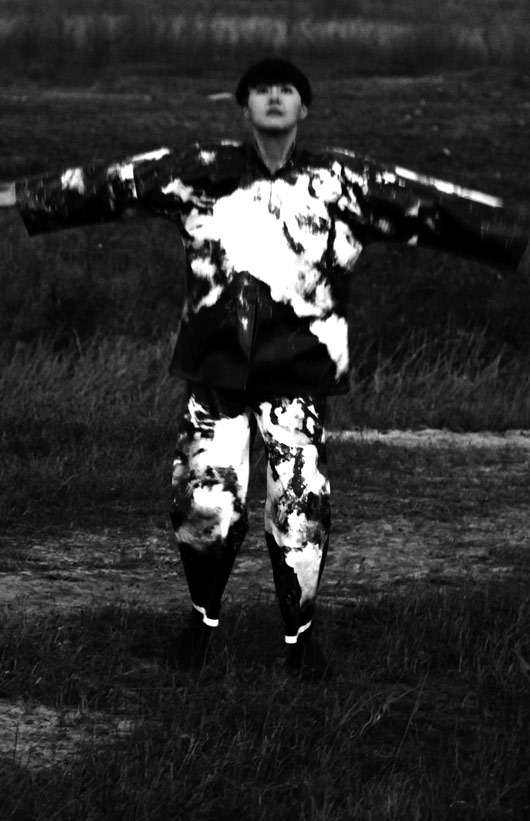
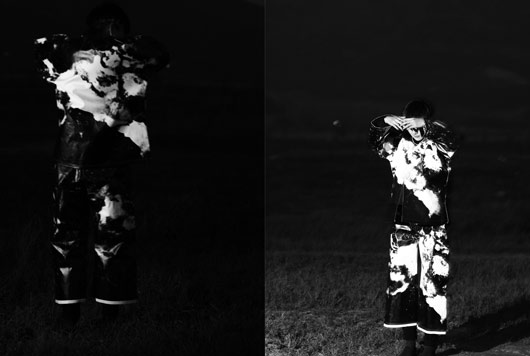
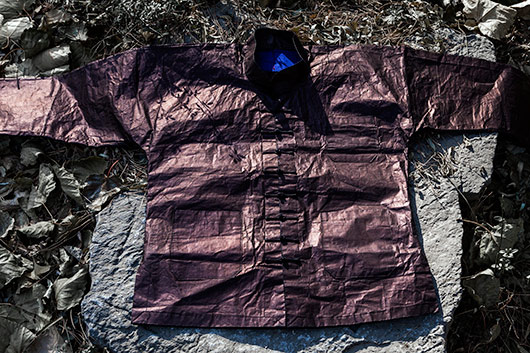
post date: 2013/12/14